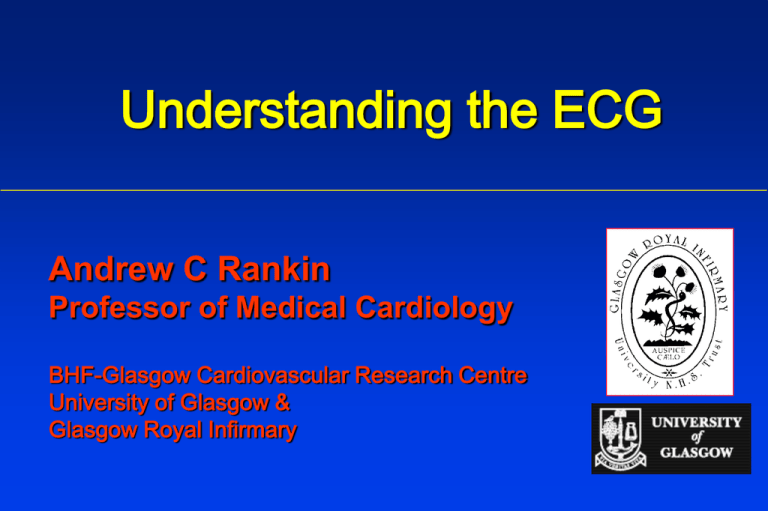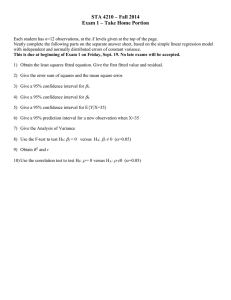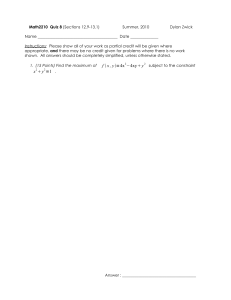Understanding the ECG Andrew C Rankin Professor of Medical Cardiology
advertisement

Understanding the ECG Andrew C Rankin Professor of Medical Cardiology BHF-Glasgow Cardiovascular Research Centre University of Glasgow & Glasgow Royal Infirmary The 12-lead ECG 6 - Limb leads 3 bipolar 3 unipolar 6 - Chest Leads The Physics The Physics Bipolar leads • Measures the potential difference between two points Unipolar Leads • Effectively measures the potential variation at a single point (reference = Wilson’s Central Terminal) Bipolar leads aVL aVR I II Unipolar Leads III aVF The Physics Bipolar leads • Leads I, II and III Unipolar Leads • aVR, aVL, aVF (a = augmented) • V1 – V6 Limb leads Chest leads ECG leads & the heart • II, III, aVF = Inferior • V1-V6 = Anterior • I, aVL, V6 = Lateral Lateral Inferior Anterior Cardiac Cycle and the ECG R T P Q S V1 r q V6 V1 S R V6 A systematic approach to the ECG R • Rate • Rhythm T wave P – regular or irregular? • P waves (leads II, V1) Q S – specific rhythm diagnosis • Intervals and durations – PR, QRS, QT • QRS complexes (axis and morphology) • ST segment / T wave changes Rate Rate? Normal? Fast? Slow? Reading ECG Squares Intervals and Timing • • • • Paper speed = 25mm/sec 5 large squares per second Each large square = 200 ms Each small square = 40 ms Rate • Paper speed = 25mm/sec • 5 large squares per second • Heart rate 60 bpm = 1 beat per second • RR interval of 1 second = 60 bpm • RR interval of 5 large squares = 60 bpm Rate = 300 divided by the number of large squares between each QRS complex Rate 300 divided by the number of large squares between each QRS complex 1 square - 300/min 2 squares - 150/min 3 squares - 100/min 4 squares - 75/min 5 squares - 60/min 6 squares - 50/min OR - 1500 divided by the number of small squares between each QRS complex Rate How fast is this rhythm? RR interval = 2 squares Rate = 300/2 = 150 bpm Rhythm Rhythm Regular? or Irregular? Rhythm Regular? or Irregular? P waves? Sinus Bradycardia Sinus Arrest First Degree AV Block • PR interval > 200 ms (1 large square) • Delayed conduction through the conducting system (AV node or distal) - Example shows PR Interval = 320 ms Second Degree AV Block – type I Known as Wenckebach Block Progressive prolongation of the PR interval until there is failure to conduct and a ventricular beat is dropped AV nodal block Second Degree AV Block – type II Dropped beats with constant preceding PR interval Distal conduction system block Third Degree AV Block Complete Heart Block No impulse conduction from the atria to the ventricles Premature Atrial Contraction Premature Ventricular Contraction Atrial Fibrillation (AF) • Irregular rhythm • Absence of P waves • Fibrillatory wave Supraventricular tachycardia • Narrow complex tachycardia • Regular Ventricular Tachycardia • Broad complex tachycardia • Regular Ventricular Fibrillation • Rapid irregular ventricular rhythm • Cardiac arrest Intervals & durations Reading ECGs Intervals and Timing Normal Ranges in seconds: PR Interval QRS Complex QT Interval 0.12 – 0.2 s 0.06 – 0.1 s 0.36 – 0.44 s Reading ECGs Intervals and Timing Upper Normal Ranges in squares: PR Interval <1 large square QRS Complex < 3 small squares QT Interval <12 small squares QRS complexes Cardiac axis • Normal axis is towards cardiac apex (-30° to 90º) aVL aVR I + II positive = normal • I +ve, II -ve = LAD • I -ve, II +ve = RAD I II III aVF http://www.blaufuss.org Left anterior hemiblock Left anterior hemi-fascicle Left posterior hemi-fascicle Left Bundle Branch Block V6 V1 W LBBB WiLLiaM M Right Bundle Branch Block V6 V1 M RBBB MaRRoW W? Broad Complex Tachycardia Broad complex tachycardia Bundle branch block SVT OR VT ? ST segment ST elevation Acute Myocardial Infarction “Current of injury” ST elevation Old Myocardial Infarction “Myocardial window” Q wave Pathological Q wave >0.04s ST depression Left Ventricular Hypertrophy ECG criteria for LVH e.g. SV1 + RV5 > 3.5 mV (35 mm) A systematic approach to the ECG R • Rate • Rhythm T wave P – regular or irregular? • P waves Q S – specific rhythm diagnosis • Intervals and durations – PR, QRS, QT • QRS complexes (axis and morphology) • ST segment / T wave changes


